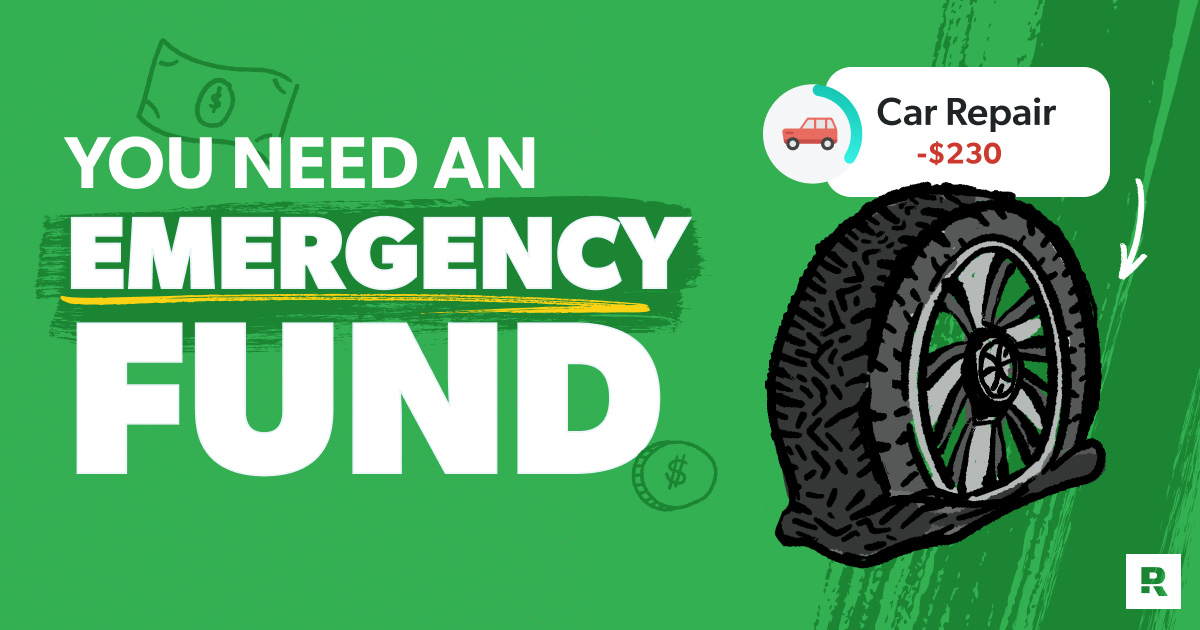Emergency Fund: Why You Need One and How Much to Save
9 Min Read | Nov 19, 2024

Key Takeaways
- An emergency fund is money you set aside for large, unexpected expenses—like car repairs or medical costs.
- How much you save for your emergency fund depends on your household, income and debt—but you should aim to save 3–6 months of expenses.
- You can keep your emergency fund in a simple savings account, money market account or high-yield savings account.
Life happens. You crack a tooth on a popcorn kernel. The AC goes out in the middle of summer. Your car breaks down on the side of the road.
Without an emergency fund, moments like these can quickly turn into a financial nightmare. But when you already have money set aside, you don’t have to worry about how to cover the bills. You can rest easy knowing you have enough to get through it.
Sounds nice, right? I’m breaking down everything you need to know about emergency funds—so you can experience the peace that savings will bring.
What Is an Emergency Fund?
Why You Need an Emergency Fund
How Much to Save for Your Emergency Fund
Where to Keep Your Emergency Fund
When You Should Use Your Emergency Fund
How to Build an Emergency Fund
Start Saving Your Emergency Fund Today
What Is an Emergency Fund?
An emergency fund is money you set aside for large, unexpected expenses. It’s a safety net, a buffer between you and life.
Your grandmother probably called her emergency fund a “rainy-day fund” and with good reason! It’s going to rain. And sometimes, it’ll flood. But with an emergency fund, you’ll be ready.
You can use an emergency fund for things like:
- Car repairs
- Medical expenses
- Job loss
- Immediate home repairs not covered by insurance
Why You Need an Emergency Fund
I can think of so many reasons why you need an emergency fund, but here are the most important ones:
- An emergency fund prepares you for the unexpected. A budget helps you plan for regular expenses each month—like groceries, gas, insurance, etc. But what about those big expenses you can’t plan for? With an emergency fund, you’re ready for just about anything that may come your way.
- An emergency fund protects you from debt. Emergencies are expensive enough without you paying interest on them for months. But instead of having to reach for the credit card, take out a loan, (or worst of all) borrow from your retirement, you can cover the big and small surprises in cash. An emergency fund gives you the power to pay in full and then move on.
- An emergency fund gives you peace of mind. According to Ramsey Solutions research, 48% of Americans say they wouldn’t be able to cover their expenses for 90 days if they lost their income—and 33% of them have no savings at all. That’s enough to keep anyone up at night. But you don’t have to live like that! Having money set aside, just in case, gives you so much peace of mind.
How Much to Save for Your Emergency Fund
Starter Emergency Fund
If you have consumer debt (that’s any debt besides your mortgage), you need to save a starter emergency fund of $1,000. The key word here is starter. I know $1,000 won't cover every emergency, but it’s enough to deal with most things while you focus on paying off your debt.
Fully Funded Emergency Fund
Once you’re debt-free, you need a fully funded emergency fund of 3–6 months of expenses. How do you know if you should save up three months or six months of expenses? Good question! It really depends on your household and income. But here are some general rules to help you decide.
Are you prepared for life’s emergencies? Learn how to get there with Financial Peace University.
Save three months of expenses if:
- You’re single with no dependents and a stable income.
- You’re married and each of you has a stable income.
Save six months of expenses if:
- You’re married with a single income.
- You’re a single parent.
- Your job is seasonal.
- Someone in your home is chronically ill.
- You or your spouse is self-employed, works on commission, or has a highly irregular income.
What’s a Good Amount to Have in Your Emergency Fund?
Start by taking a look at your budget or your bank account to see what you usually spend each month. Then multiply that number by three or six months to get an idea of how much you should save for your emergency fund.
As an example, the average monthly expenses in America range from about $4,300 for singles up to nearly $9,200 for a family of four.1 So that would be $4,300 x 3 = $12,900 for a three-month emergency fund. Or you could do $9,200 x 6 = $55,200 for a six-month emergency fund.
Now, those numbers are based on everything in the budget—including streaming services, eating out, haircuts, etc. But, worst-case scenario, if you lose your job and have to live off your emergency fund for a couple months, you’ll need to scale back to a bare-bones budget that just covers the essentials. It’s not the time to spend money on fancy extras.
With that in mind, make sure you’ve got enough in your emergency fund to pay your bills, put food on the table, and fill up the gas tank (your Four Walls). And if you want a bigger cushion for added peace of mind, that’s okay too!
Save more. Spend better. Budget confidently.
Get EveryDollar: the free app that makes creating—and keeping—a budget simple. (Yes, please.)
Where to Keep Your Emergency Fund
Now that you know how much to save, you might be wondering about where you should keep your emergency fund.
The most important thing is to make sure your emergency fund is liquid—meaning you can get to it easily and quickly. That said, let’s talk about the best places to put your emergency fund:
- A simple savings account connected to your checking account
- A money market account that comes with a debit card or check-writing privileges
- A high-yield savings account that pays a higher interest rate and allows you to transfer money quickly and directly to your checking account
- Not in a shoebox in your sock drawer or buried in the backyard
- Not in an investment account where it could lose value in the short term (your emergency fund is insurance—not an investment)
The key is security and accessibility. You want to be able to pay that doctor or mechanic quickly with zero hassle and headaches. But you also don’t want the money so easy to get to that you’re dipping into it for every little reason. Which brings me to my next point . . .
When You Should Use Your Emergency Fund
So, a sudden expense pops up, and it feels like an emergency—but how do you know if it’s really time to tap into your emergency fund?
First off, can you simply adjust your budget for the month instead of dipping into your savings? See where you can cut back your spending to help you cover the cost (the eating out category is always a good place to start).
The less you have to take out of your emergency fund, the better. Because remember, once you spend from your emergency fund, you have to rebuild your emergency fund.
If you’ve moved things around in the budget and it’s still not enough, you need to ask yourself these three questions before you use your emergency fund:
- Is it unexpected?
- Is it necessary?
- Is it urgent?
If the answer is yes to all three, you’ve got a real emergency—and a real need to use your emergency fund. If not, then it can wait. (Spoiler alert: Christmas gifts are not an emergency.)
“An emergency fund turns a financial crisis into an inconvenience.”— Rachel Cruze
How to Build an Emergency Fund
Don’t have an emergency fund yet? Or are you realizing that yours isn’t big enough? Well, there’s no better time than right now to start saving! Follow these steps to build your emergency fund:
1. Set a savings goal.
Whether it’s $1,000 for your starter emergency fund or 3–6 months of expenses for your fully funded emergency fund, you need to know what number you’re working toward. And if that means saving a bit more to have extra financial security, go for it.
Also, if you’re married, make sure it’s a number you both agree on. You’ll be working together to save it up, and that’ll be so much easier if you’re on the same page financially.
2. Make a budget.
Once you know the amount you’re aiming for, you can start breaking down how to get there. And this is where a budget comes in!
A budget is simply a plan for where your money will go. If you want to put money into savings, you have to plan for it—aka put it in the budget.
If your goal is to save $1,000, then get intense and knock it out this month (I know you can do it). If you’re working on your fully funded emergency fund, create a savings budget line and work on this goal one month at a time.
Here's A Tip
Need some help getting started? Check out my favorite budgeting app, EveryDollar. It makes it super easy to create a budget that works for you and your goals. And the best part, it’s free!
3. Lower your expenses.
No matter how much you’re trying to save, if you don’t have extra money in your budget already, something’s got to give.
Start by lowering your expenses. There are plenty of ways to spend less or cut costs completely. The best place to start is in the kitchen by meal planning!
4. Increase your income.
Another way to ramp up your savings each month is by increasing your income. You can work overtime or ask for extra hours, grab a side hustle, or sell stuff for a quick income boost.
Do what you need to get some extra cash flowing into your budget. Just remember to stay on track. You don’t want to accidentally spend it elsewhere—you’ve got goals to hit and an emergency fund to build.
5. Automate your savings.
One last tip on building your emergency fund: You know that monthly amount you decided to stick into savings? Go ahead and set it to transfer into your savings automatically from your paycheck. That way, you won’t even think about sending it on a detour to concert tickets, store sales or whatever other temptation might come your way each month.
That money has a job: to go into savings. So help yourself by sending it straight there!
Start Saving Your Emergency Fund Today
Now you’ve got all the info you need to start saving. So figure out your savings goal, download EveryDollar to put that goal in the budget, and start working to build up your emergency fund.
That peace of mind I keep talking about isn’t a fairy tale. It’s real. And when you have a fully funded emergency fund sitting in the bank, you’ll know exactly what I’m talking about. Take those first steps and start saving today!


